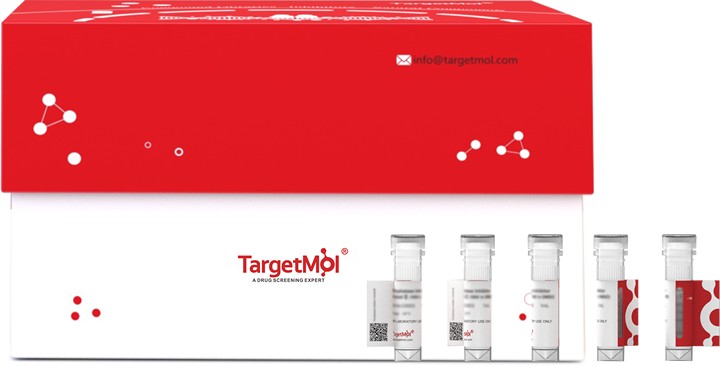- 全部删除
 您的购物车当前为空
您的购物车当前为空
CPLX2 Protein, Human, Recombinant (His)
Complexin-2 (CPLX2), a member of the complexin/synaphin family, is a soluble pre-synaptic protein believed to regulate neurotransmitter release from pre-synaptic terminals. Complexins are soluble proteins that regulate the activity of soluble N-ethylmaleimide-sensitive factor attachment protein receptor (SNARE) complexes necessary for vesicle fusion. Complexins are unable to bind to monomeric SNARE proteins but bind with high affinity to ternary SNARE complexes and with lower affinity to target SNARE complexes. Complexin 1 (CX1) and complexin 2 (CX2) are presynaptic proteins that modulate neurotransmitter release and are used as markers of inhibitory and excitatory synapses, respectively. CPLX2 is localized in pre-synaptic terminals in mature brain. The G71-P89 region of CPLX2 is essential and sufficient for preferential axonal distribution. CPLX2 participates in the Ca(2+)-sensitive regulatory pathway for zymogen granule exocytosis. Complexin-2 is a key player in normal neurological function, and its downregulation could lead to changes in neurotransmitter release sufficient to cause significant behavioural abnormalities such as depression. It is involved in synaptogenesis and the modulation of neurotransmitter release.

CPLX2 Protein, Human, Recombinant (His)
| 规格 | 价格 | 库存 | 数量 |
|---|---|---|---|
| 100 μg | ¥ 4,460 | 5日内发货 |
产品信息
| 生物活性 | Activity testing is in progress. It is theoretically active, but we cannot guarantee it. If you require protein activity, we recommend choosing the eukaryotic expression version first. |
| 产品描述 | Complexin-2 (CPLX2), a member of the complexin/synaphin family, is a soluble pre-synaptic protein believed to regulate neurotransmitter release from pre-synaptic terminals. Complexins are soluble proteins that regulate the activity of soluble N-ethylmaleimide-sensitive factor attachment protein receptor (SNARE) complexes necessary for vesicle fusion. Complexins are unable to bind to monomeric SNARE proteins but bind with high affinity to ternary SNARE complexes and with lower affinity to target SNARE complexes. Complexin 1 (CX1) and complexin 2 (CX2) are presynaptic proteins that modulate neurotransmitter release and are used as markers of inhibitory and excitatory synapses, respectively. CPLX2 is localized in pre-synaptic terminals in mature brain. The G71-P89 region of CPLX2 is essential and sufficient for preferential axonal distribution. CPLX2 participates in the Ca(2+)-sensitive regulatory pathway for zymogen granule exocytosis. Complexin-2 is a key player in normal neurological function, and its downregulation could lead to changes in neurotransmitter release sufficient to cause significant behavioural abnormalities such as depression. It is involved in synaptogenesis and the modulation of neurotransmitter release. |
| 种属 | Human |
| 表达系统 | E. coli |
| 标签 | N-His |
| 蛋白编号 | Q6PUV4-1 |
| 别名 | Hfb1,CPX-2,CPX2,complexin 2,921-L |
| 蛋白构建 | A DNA sequence encoding the human CPLX2 (Q6PUV4-1) (Asp 2-Lys 134) was expressed, with a polyhistide tag at the N-terminus. Predicted N terminal: Met |
| 蛋白纯度 | > 90 % as determined by SDS-PAGE |
| 分子量 | 16.8 kDa (predicted); 21 kDa (reducing conditions) |
| 内毒素 | Please contact us for more information. |
| 缓冲液 | Lyophilized from a solution filtered through a 0.22 μm filter, containing PBS, pH 7.4. Typically, a mixture containing 5% to 8% trehalose, mannitol, and 0.01% Tween 80 is incorporated as a protective agent before lyophilization. |
| 复溶方法 | A Certificate of Analysis (CoA) containing reconstitution instructions is included with the products. Please refer to the CoA for detailed information. |
| 存储 | It is recommended to store recombinant proteins at -20°C to -80°C for future use. Lyophilized powders can be stably stored for over 12 months, while liquid products can be stored for 6-12 months at -80°C. For reconstituted protein solutions, the solution can be stored at -20°C to -80°C for at least 3 months. Please avoid multiple freeze-thaw cycles and store products in aliquots. |
| 运输方式 | In general, Lyophilized powders are shipping with blue ice. |
| 研究背景 | Complexin-2 (CPLX2), a member of the complexin/synaphin family, is a soluble pre-synaptic protein believed to regulate neurotransmitter release from pre-synaptic terminals. Complexins are soluble proteins that regulate the activity of soluble N-ethylmaleimide-sensitive factor attachment protein receptor (SNARE) complexes necessary for vesicle fusion. Complexins are unable to bind to monomeric SNARE proteins but bind with high affinity to ternary SNARE complexes and with lower affinity to target SNARE complexes. Complexin 1 (CX1) and complexin 2 (CX2) are presynaptic proteins that modulate neurotransmitter release and are used as markers of inhibitory and excitatory synapses, respectively. CPLX2 is localized in pre-synaptic terminals in mature brain. The G71-P89 region of CPLX2 is essential and sufficient for preferential axonal distribution. CPLX2 participates in the Ca(2+)-sensitive regulatory pathway for zymogen granule exocytosis. Complexin-2 is a key player in normal neurological function, and its downregulation could lead to changes in neurotransmitter release sufficient to cause significant behavioural abnormalities such as depression. It is involved in synaptogenesis and the modulation of neurotransmitter release. |




